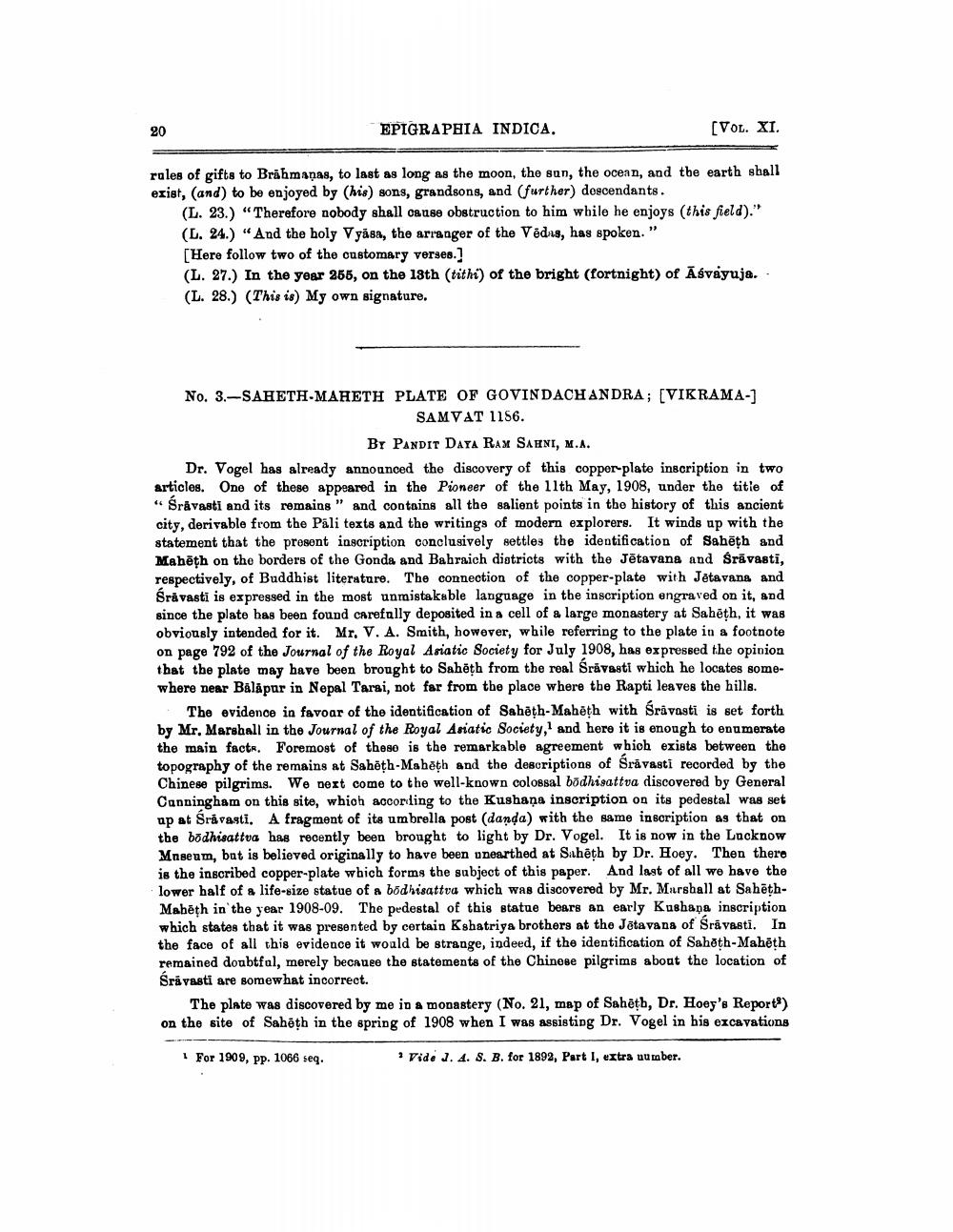________________
20
EPIGRAPHIA INDICA.
(VOL. XI.
roles of gifts to Brühmanas, to last as long as the moon, the sun, the ocean, and the earth shall exist, (and) to be enjoyed by (his) sons, grandsons, and further) descendants.
(L. 23.) "Therefore nobody shall cause obstruction to him while he enjoys (this field)." (L. 24.) “And the holy Vyasa, the arranger of the Vedas, has spoken." [Here follow two of the customary verses.] (L. 27.) In the year 255, on the 18th (titht) of the bright (fortnight) of Āsvayuja.. (L. 28.) (This is) My own signature.
No. 3.-SAHETH-MAHETH PLATE OF GOVINDACH ANDRA; [VIKRAMA-]
SAMVAT 1156.
Br PANDIT DATA RAX SAHNI, M.A. Dr. Vogel has already announced the discovery of this copper-plate inscription in two articles. One of these appeared in the Pioneer of the 11th May, 1908, under the title of "Śråvasti and its remains" and contains all the salient points in the history of this ancient city, derivable from the Pali texts and the writings of modern explorers. It winds up with the statement that the present inscription conclusively settles the identification of Sabēth and Mahēth on the borders of the Gonda and Babraich districts with the Jētavana and Srivasti, respectively, of Buddhist literature. The connection of the copper-plate with Jetavana and Śråvasti is expressed in the most unmistakable language in the inscription engraved on it, and since the plate has been found carefully deposited in a cell of a large monastery at Sahēth, it was obviously intended for it. Mr. V. A. Smith, however, while referring to the plate in a footnote on page 792 of the Journal of the Royal Asiatic Society for July 1908, has expressed the opinion that the plate may have been brought to Sabēth from the real Sråvasti which he locates somewhere near Balapur in Nepal Tarai, not far from the place where the Rapti leaves the hills.
The evidence in favoar of the identification of Sahēth-Mabeth with Srivasti is set forth by Mr. Marshall in the Journal of the Royal Asiatic Society, and here it is enough to enumerate the main factr. Foremost of these is the remarkable agreement which exists between the topography of the remains at Sahēth-Mahēth and the descriptions of Srivasti recorded by the Chinese pilgrims. We next come to the well-known colossal bodhisattva discovered by General Canningham on this site, which according to the Kushana inscription on its pedestal was set ap at Srivasti. A fragment of its umbrella post (danda) with the same inscription as that on the bodhisattva has recently been brought to light by Dr. Vogel. It is now in the Lacknow Mnseum, but is believed originally to have been unearthed at Sahēth by Dr. Hoey. Then there is the inscribed copper-plate which forms the subject of this paper. And last of all we have the lower half of a life-size statue of a bodhisattva which was discovered by Mr. Mirshall at SahēthMabēth in the year 1908-09. The pedestal of this statue bears an early Kushana inscription which states that it was presented by certain Kshatriya brothers at the Jētavana of Srivasti. In the face of all this evidence it would be strange, indeed, if the identification of Sahoth-Mahēth remained doubtfal, merely becauee the statements of the Chinese pilgrims about the location of Śrávasti are somewhat incorrect.
The plate was discovered by me in a monastery (No. 21, map of Sahētb, Dr. Hoey's Report) on the site of Sahēth in the spring of 1908 when I was assisting Dr. Vogel in his excavations
For 1909, pp. 1066 seg.
· Vide 1. 4. S. B. for 1892, Part I, extra uu taber.




